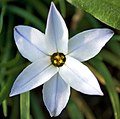
The flowering plant genus Ipheion belongs to Allioideae, a subfamily of the family Amaryllidaceae. The World Checklist of Selected Plant Families no longer recognize the genus, regarding it as a synonym of Tristagma, although The Plant List accepts two species.

Hibiscus syriacus is a species of flowering plant in the mallow family, Malvaceae. It is native to south-central and southeast China, but widely introduced elsewhere, including much of Asia, both in the east and the west. It was given the epithet syriacus because it had been collected from gardens in Syria. Common names include the rose of Sharon,, Syrian ketmia, shrub althea, and rose mallow. It is the national flower of South Korea and is mentioned in the South Korean national anthem.

Hyacinthus orientalis, the common hyacinth, garden hyacinth or Dutch hyacinth, is a species of flowering plant in the family Asparagaceae, subfamily Scilloideae, native to southwestern Asia, southern and central Turkey, northwestern Syria, Lebanon and northern Israel. It was introduced to Europe in the 16th century. It is widely cultivated everywhere in the temperate world for its strongly fragrant flowers which appear exceptionally early in the season, and frequently forced to flower at Christmas time.

Salvia guaranitica, the anise-scented sage or hummingbird sage, is a species of flowering plant in the sage family, Lamiaceae, native to a wide area of South America, including Brazil, Paraguay, Uruguay, and Argentina. It is cultivated all over the world, and is naturalized in New Zealand and Chile.

Lavandula angustifolia, formerly L. officinalis, is a flowering plant in the family Lamiaceae, native to the Mediterranean. Its common names include lavender, true lavender and English lavender ; also garden lavender, common lavender and narrow-leaved lavender.

Cornus alba, the red-barked, white or Siberian dogwood, is a species of flowering plant in the family Cornaceae, native to Siberia, northern China and Korea. It is a large deciduous surculose (suckering) shrub that can be grown as a small tree. As a popular ornamental used in landscaping its notable features include the red stems in fall (autumn) through late winter, bright winter bark; and the variegated foliage in some cultivars, such as C. alba 'Elegantissima'. C. alba can grow to 3 m (10 ft) high, but variegated forms are less vigorous. For the brightest winter bark, young shoots are encouraged by cutting to the ground some older stems at the end of the winter, before leaves are open. The oval fruits are white, sometimes tinted blue.
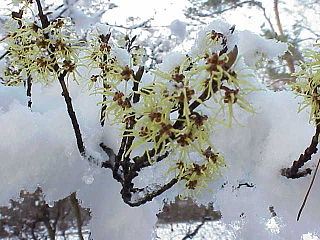
Hamamelis mollis, also known as Chinese witch hazel, is a species of flowering plant in the witch hazel family Hamamelidaceae, native to central and eastern China, in Anhui, Guangxi, Hubei, Hunan, Jiangxi, Sichuan, and Zhejiang.

Skimmia japonica, the Japanese skimmia, is a species of flowering plant in the family Rutaceae, native to Japan, China, and Southeast Asia. Growing to 6 m (20 ft) tall and wide, it is a rounded evergreen shrub with glossy, leathery leaves. It is widely cultivated as an ornamental plant in gardens and parks. Its fragrant flowers are cream-yellow or white, followed on female plants by small, round, red fruits. The plant tolerates a wide range of conditions, including frost, drought, and atmospheric pollution. It is suitable for bonsai and for Chinese gardens.
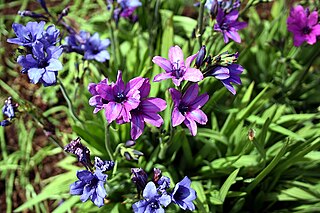
Babiana stricta, the baboon flower or blue freesia, is a species of flowering plant in the family Iridaceae, native to Cape Province, South Africa and naturalized in Australia. Growing 10–30 cm (4–12 in) tall by 5 cm (2 in) broad, it is a cormous perennial with hairy leaves 4–12 cm (2–5 in) long. The leaves show linear venation.
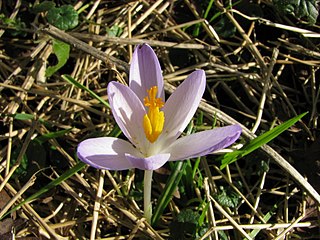
Crocus tommasinianus, the woodland crocus, early crocus, or Tommasini's crocus, is a flower named after the botanist Muzio G. Spirito de Tommasini (1794-1879). It is native to Bulgaria, Hungary, Albania, and the former Yugoslavia. It is often referred to as the early or snow crocus, but these terms are shared with several other species, although C. tommasinianus is amongst the first to bloom. Multiple plants are often called tommies in the horticultural trade.

Veronica prostrata, the prostrate speedwell or rock speedwell, is a species of flowering plant in the family Plantaginaceae, native to Europe. Growing to 10–15 cm (4–6 in) tall, it is a temperate semi-evergreen prostrate perennial plant. As it forms a mat of foliage, it is suitable for groundcover or in the alpine garden. Blue flowers are borne in summer, in terminal racemes above paired leaves.

Tecophilaea cyanocrocus, the Chilean blue crocus, is a flowering perennial plant that is native to Chile, growing at 2,000 to 3,000 m elevation on dry, stony slopes in the Andes mountains. Although it had survived in cultivation due to its use as a greenhouse and landscape plant, it was believed to be extinct in the wild due to overcollecting, overgrazing, and general destruction of habitat, until it was rediscovered in 2001.

Zephyranthes tubispatha, synonym Habranthus tubispathus, the Rio Grande copperlily or Barbados snowdrop, is a species of flowering plant in the family Amaryllidaceae. It is a perennial bulb native to southern South America. It is widely cultivated as an ornamental and reportedly naturalized in the southeastern United States, much of the West Indies as well as Bermuda, eastern Mexico, India, Easter Island, and central Chile.

Muscari aucheri, Aucher-Éloy grape hyacinth, is a species of flowering plant in the squill subfamily Scilloideae of the asparagus family Asparagaceae. It is a perennial bulbous plant, one of a number of species and genera known as grape hyacinths. Originally from Turkey, where it grows in grassy alpine areas, it is sometimes grown as an ornamental plant. The synonym M. tubergenianum may be found in the horticultural literature.
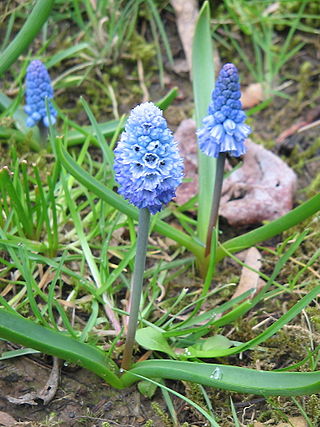
Pseudomuscari azureum, the azure grape hyacinth, is a species of flowering plant in the family Asparagaceae, native to Turkey. A bulbous perennial, it is grown in gardens for its spring flowers. The Latin specific epithet azureum means "bright blue", a reference to its flower colour.

Iris aucheri, the Aucher-Éloy iris, is a species of flowering plant in the family Iridaceae. It is a bulbous perennial in the Juno group of irises.

Narcissus bulbocodium, the petticoat daffodil or hoop-petticoat daffodil, is a species of flowering plant in the family Amaryllidaceae, native to southern and western France, Portugal, and Spain. Some sources say that the species is also native to Morocco, but this is based on populations formerly thought to be varieties of N. bulbocodium but now regarded as separate species.

Narcissus cyclamineus, the cyclamen-flowered daffodil, is a species of flowering plant in the family Amaryllidaceae, native to North West Portugal and North West Spain.
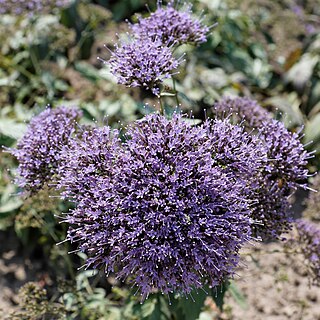
Trachelium caeruleum, common name blue throatwort, is a species of flowering plant in the family Campanulaceae native to the Mediterranean, where its native range includes Algeria, Morocco, Portugal, Spain, and Sicily. It has also become naturalized in a few areas, including New Zealand, the Azores, and parts of mainland Europe.
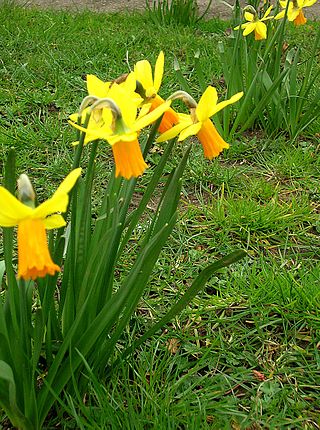
Narcissus 'Jetfire' is a cultivar of dwarf Narcissus, which was introduced in 1966. It is one of many cultivars produced by American daffodil breeder Grant E. Mitsch. 'Jetfire' is a popular early flowering ornamental plant utilized in gardens, where it can be planted into borders, flowerpots, and naturalized in lawns. The cultivar has received multiple awards, including the Award of Garden Merit from the Royal Horticultural Society.

